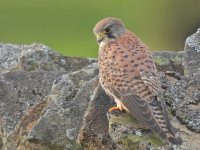PaulCountyDurham
Well-known member

Hi all,
Can anyone age this Kestrel?
The picture was taken yesterday. It's windy and there's no sun, and it's pretty much the picture straight out of the camera with the exception of a bit of contrast added. The point of saying that is that I don't think there's any colour distortion in this picture.
I think the bird is a male who hasn't developed full adult plumage yet, e.g. grey tail. The bird looks like it's developing adult plumage on the mantle and coverts. Also, is that the beginning of a grey tail growing in his upper tail feathers?
Thanks in advance (and of course I could be completely wrong in my cursory assessment).
Can anyone age this Kestrel?
The picture was taken yesterday. It's windy and there's no sun, and it's pretty much the picture straight out of the camera with the exception of a bit of contrast added. The point of saying that is that I don't think there's any colour distortion in this picture.
I think the bird is a male who hasn't developed full adult plumage yet, e.g. grey tail. The bird looks like it's developing adult plumage on the mantle and coverts. Also, is that the beginning of a grey tail growing in his upper tail feathers?
Thanks in advance (and of course I could be completely wrong in my cursory assessment).






